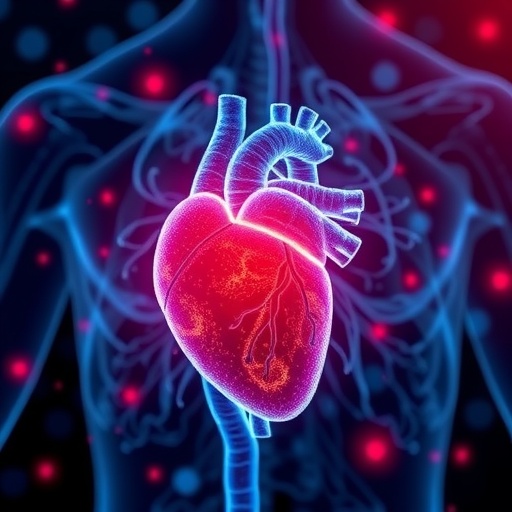In a groundbreaking advancement that merges forensic science with cutting-edge analytical technologies, researchers have unveiled a novel method to distinguish causes of death and identify pathological stages in acute ischemic heart disease (AIHD). This condition, a major global health challenge, often culminates in sudden death, making precise postmortem diagnosis both critical and complex. Leveraging the sensitivity of plasma lipidomic profiling combined with sophisticated machine learning algorithms, the study opens new frontiers in forensic pathology, promising more accurate, reliable, and early identification of death causes associated with AIHD.
Acute ischemic heart disease, primarily caused by the obstruction of coronary arteries, leads to rapid myocardial tissue damage due to oxygen deprivation. A paramount challenge in forensic investigations is differentiating death caused by AIHD from other cardiac-related or systemic causes, especially when traditional morphological signs are subtle or ambiguous. The research team addressed this problem by shifting focus to the molecular footprint left in the blood—a terrain teeming with lipids whose profiles dynamically change during ischemic events.
Lipidomics, the comprehensive study of the diverse lipid species within biological systems, has revolutionized our understanding of disease pathogenesis and progression. By analyzing plasma lipids, this study capitalizes on the unique biochemical signatures reflective of ischemic damage. These signatures can be harnessed as biomarkers, serving as molecular fingerprints that narrate the underlying pathological processes leading to death. The researchers utilized advanced mass spectrometry techniques to generate an extensive plasma lipid profile, capturing minute variations that traditional analyses would overlook.
Critical to the success of this approach is the integration of machine learning. The enormous datasets produced by lipidomic analyses demand powerful computational tools for interpretation. Machine learning algorithms, capable of discerning complex patterns and relationships within high-dimensional data, were trained on plasma lipid profiles from confirmed cases of AIHD and controls. Through iterative learning and validation, the models refined their predictive accuracy, enabling robust discrimination between AIHD-induced deaths and other causes.
The study’s innovation lies not only in its diagnostic potential but also in its ability to stage the pathological progression of AIHD, a feature rarely addressed in forensic contexts. Understanding whether the ischemic event was acute, subacute, or chronic carries immense implications for legal medicine and epidemiology. By correlating distinct lipidomic patterns with different pathological stages, the research offers a timeline of ischemic damage, enhancing the fidelity of death investigations and potentially informing targeted therapeutic interventions if applied clinically.
Experiments demonstrated that specific classes of lipids, such as phospholipids, sphingolipids, and fatty acids, exhibited significant alterations in concentration during AIHD. These changes likely reflect cellular membrane disruption, oxidative stress, and inflammatory responses inherent to myocardial ischemia. Machine learning models successfully harnessed these alterations, achieving impressive sensitivity and specificity metrics that outperformed conventional biomarkers and morphological assessment alone.
This methodological marriage—lipidomics coupled with artificial intelligence—champions a paradigm shift in postmortem diagnostics, offering a molecular lens through which the previously impenetrable nuances of sudden cardiac death can be explored. Notably, the approach is minimally invasive; plasma samples collected postmortem promise to be a rich resource for biochemical interrogation without necessitating extensive tissue fixation or prolonged histopathological processing.
Moreover, the implications extend beyond forensics into clinical cardiology. Early-stage identification of ischemic insults via plasma lipids could revolutionize risk stratification, patient monitoring, and personalized treatment strategies. The translational potential is vast, envisaging a future where plasma lipid profiling integrated with AI algorithms aids both living patients and forensic cases alike.
Nevertheless, the researchers caution that this preliminary study serves as foundational work needing expansive validation. Larger cohorts, diverse populations, and multi-center collaborations will be essential to generalize findings and refine algorithmic performance. Additionally, standardizing pre-analytical variables and ensuring reproducibility remain critical hurdles before clinical or forensic adoption.
The intersection of lipid biochemistry, computational science, and legal medicine underscores the interdisciplinary nature of modern scientific breakthroughs. This study exemplifies how leveraging molecular insights alongside machine intelligence can transcend traditional boundaries, offering solutions to long-standing diagnostic conundrums in forensic pathology.
Future research trajectories may explore integrating additional omics layers—such as proteomics and metabolomics—with lipidomics to construct even more comprehensive molecular signatures of AIHD. Furthermore, expanding the AI toolkit to include deep learning architectures might uncover subtler, nonlinear relationships within the data, enhancing predictive robustness.
In conclusion, this pioneering investigation heralds a new era in cause-of-death discrimination in acute ischemic heart disease. By charting the uncharted molecular landscapes of plasma lipids and decoding them via machine learning, it equips forensic experts with unprecedented precision tools. As the methodology matures through continued research, it holds promise not only for the courtroom but for improving cardiovascular disease outcomes globally.
Subject of Research:
Article Title:
Article References:
Ma, Xy., Sun, Cc., Wang, Tq. et al. A preliminary study on cause‑of‑death discrimination and the pathological stage identification in acute ischemia heart disease (AIHD) based on plasma lipidomic technique and machine learning algorithms.
Int J Legal Med (2025). https://doi.org/10.1007/s00414-025-03515-0
Image Credits: AI Generated




